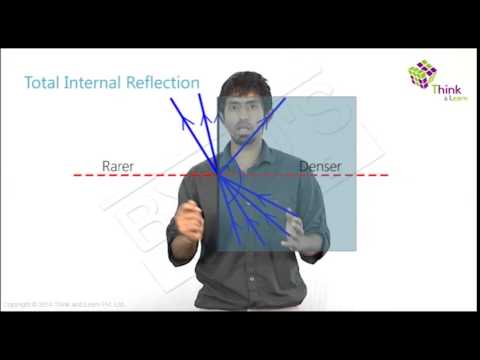What is an optical fiberTypes-of-optical-fibersHow does an optical fibre workAdvantages of optical fibre communicationFAQs
What is an Optical Fiber?
Optical fiber is the technology associated with data transmission using light pulses travelling along with a long fiber which is usually made of plastic or glass. Metal wires are preferred for transmission in optical fiber communication as signals travel with fewer damages. Optical fibers are also unaffected by electromagnetic interference. The fiber optical cable uses the application of total internal reflection of light. The fibers are designed such that they facilitate the propagation of light along with the optical fiber depending on the requirement of power and distance of transmission. Single-mode fiber is used for long-distance transmission, while multimode fiber is used for shorter distances. The outer cladding of these fibers needs better protection than metal wires.

Types of Optical Fibers
The types of optical fibers depend on the refractive index, materials used, and mode of propagation of light.
The classification based on the refractive index is as follows:
- Step Index Fibers: It consists of a core surrounded by the cladding, which has a single uniform index of refraction.
- Graded Index Fibers: The refractive index of the optical fiber decreases as the radial distance from the fiber axis increases.
The classification based on the materials used is as follows:
- Plastic Optical Fibers: The polymethylmethacrylate is used as a core material for the transmission of the light.
- Glass Fibers: It consists of extremely fine glass fibers.
The classification based on the mode of propagation of light is as follows:
- Single-Mode Fibers: These fibers are used for long-distance transmission of signals.
- Multimode Fibers: These fibers are used for short-distance transmission of signals.
The mode of propagation and refractive index of the core is used to form four combination types of optic fibers as follows:
- Step index-single mode fibers
- Graded index-Single mode fibers
- Step index-Multimode fibers
- Graded index-Multimode fibers

How Does an Optical Fibre Work?
The optical fiber works on the principle of total internal reflection. Light rays can be used to transmit a huge amount of data, but there is a problem here – the light rays travel in straight lines. So unless we have a long straight wire without any bends at all, harnessing this advantage will be very tedious. Instead, the optical cables are designed such that they bend all the light rays’ inwards (using TIR). Light rays travel continuously, bouncing off the optical fiber walls and transmitting end to end data. Although light signals do degrade over progressing distances, depending on the purity of the material used, the loss is much less compared to using metal cables. A Fibre Optic Relay System consists of the following components:
- The Transmitter – It produces the light signals and encodes them to fit to transmit.
- The Optical Fibre – The medium for transmitting the light pulse (signal).
- The Optical Receiver – It receives the transmitted light pulse (signal) and decodes them to be fit to use.
- The Optical Regenerator – Necessary for long-distance data transmission.
Advantages of Optical Fibre Communication
- Economical and cost-effective
- Thin and non-flammable
- Less power consumption
- Less signal degradation
- Flexible and lightweight
Learn more about optics, fiber optics, its application and about multimode fibers from our expert tutors at BYJU’S.
Frequently Asked Questions – FAQs
What is used for the fabrication of optical fibers that are used for communication?
Silica or multi-component glass are used for the fabrication of optical fibers.
Why is silica used for the fabrication of the optical fibers?
Silica has a perfect elasticity until it reaches the breaking point, which makes it best for the fabrication.
What is the principle of fiber optical communication?
Total internal reflection is the principle on which the optical fiber communication is based.
Name the factors that are responsible for generating attenuation of optical power in fiber.
Following are the factors that are responsible for generating attenuation of optical power in fiber:
- Absorption
- Scattering
- Waveguide effect
Why are plastic-clad silica fiber optic cables not user-friendly?
Following are the reasons why plastic-clad silica fiber optic cables not user-friendly:
- The fibers are insoluble in organic solvents
- Bonding becomes difficult
- Connector application becomes difficult as there is excessive plasticity in the cladding
What is the Raman effect?
The Raman effect is the change in the wavelength of light which occurs when the molecules deflect the light beam.
What are the benefits of optical fiber cable?
Following are the benefits of optical fiber cable:
- The data security is excellent
- It is cost-effective
- It won’t be affected by interference
What is the bandwidth of optical fiber?
900 THz is the bandwidth of the optical fiber.
What is core in the optical fiber?
The core is the inner part of the optical fiber, which carries light.
List a few advantages of optical fiber communication.
A few advantages of optical fiber communication are:
- Less signal degradation
- Thin and non-flammable
- Economical and cost-effective
- Less power consumption




Your material was helpful, thanks